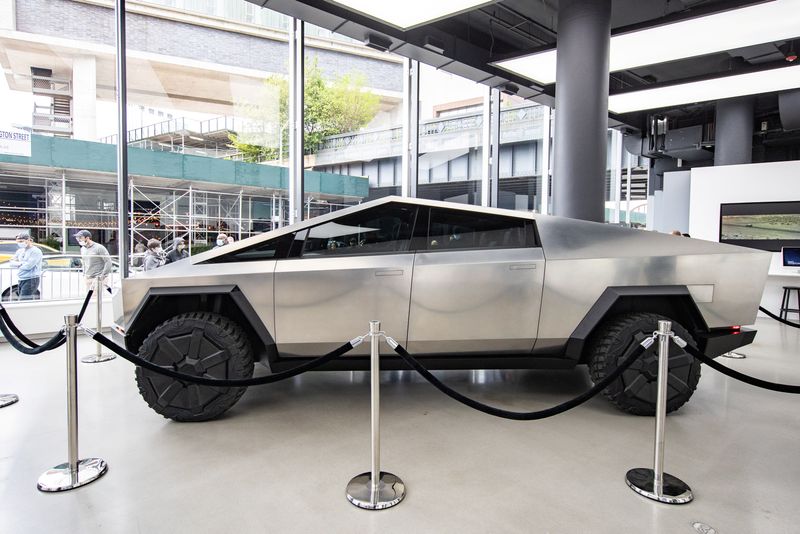(Reuters) -Tesla aims to start mass production of its Cybertruck at the end of 2023, two years after the initial target for the long-awaited pickup truck Chief Executive Elon Musk unveiled in 2019, two people with knowledge of the plans told Reuters.
Tesla (NASDAQ:TSLA) said last month it was working on readying its Austin, Texas, plant to build the new model with “early production” set to start in the middle of 2023. “We’re in the final lap for Cybertruck,” Musk told a conference call with financial analysts.
A gradual ramp in the second half of next year to full output for the sharp-angled electric truck would mean that Tesla would not be recording revenue until early 2024 for a full-quarter of production on a new model expected as key to its growth.
It would also mean a wait of another year for the estimated hundreds of thousands of potential buyers who have paid $100 to reserve a Cybertruck in one of the most highly anticipated and closely tracked electric vehicle launches ever.
Tesla did not immediately respond to a request to comment. Tesla shares were up 0.4% after rising as much as 4.3% earlier on Tuesday.
It has not announced final pricing on the Cybertruck, showed the production version of the vehicle or specified how it will manage the battery supply for the new model.
In 2019, Tesla had projected an initial price of under $40,000, but prices for new vehicles have shot higher since then and Tesla has raised prices across its lineup.
Another source said Cybertruck was designed to use Tesla's much-touted 4680 batteries. But Guidehouse Insights analyst Sam Abuelsamid said Tesla has not been able to significantly scale up production of the in-house batteries, which could lead to further delays of Cybertrucks beyond the end of 2023.
Tesla may have to significantly redesign the Cybertruck batteries to switch to conventional 2170 batteries, he added.
Musk said last month the 4680 batteries are not expected to be "any limiting factor for Cybertruck or anything else." He said the battery output was growing exponentially, without giving details about the production volume.
CRACKED WINDOWS
Musk introduced Cybertruck in a 2019 reveal where the vehicle’s designer cracked the vehicle’s supposedly unbreakable “armor glass” windows. The company has pushed back production timing three times since: from late 2021 to late 2022, then to early 2023 and most recently to the mid-2023 target for initial production.
The Cybertruck launch will give Tesla an EV entrant in one of the most profitable segments of the U.S. market and a competitor to electric pickups from the likes of Ford Motor (NYSE:F) Co and Rivian Automotive, both of which have launched models in still-limited numbers.
In January, Musk had cited shortages in sourcing components as the reason for pushing the launch of Cybertruck into 2023.
In May, Tesla stopped taking orders for the Cybertruck outside North America. Musk said then the company had "more orders of the first Cybertrucks than we could possibly fulfill for three years after the start of production."
Automakers often ramp production slowly for an all-new model like the Cybertruck.
Analysts have also cautioned that a weakening global economy will start to weigh on sales for Tesla, which has so far been able to sell every car it makes. Musk has said he expected a coming recession would last “probably until Spring of ’24.”

IDRA Group, the Italian company making the Giga Press that will be used for die casting parts for the Cybertruck, said in a LinkedIn post last week that the 9,000-ton machine for truck part production was packed and ready to be shipped.
The post did not name Tesla. Tesla has been using the Giga Press to cut the cost and complexity of production of its Model Y, an innovation other automakers, including Toyota, have studied.